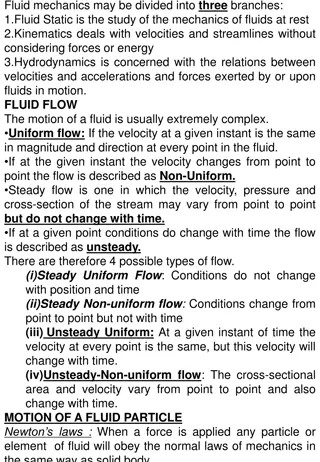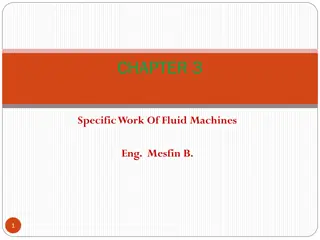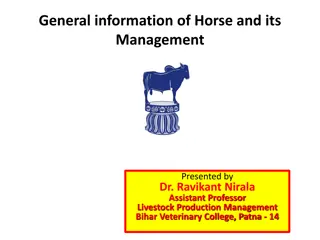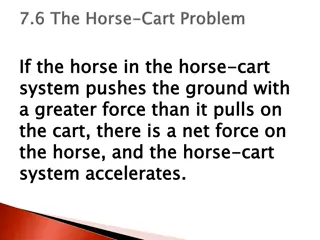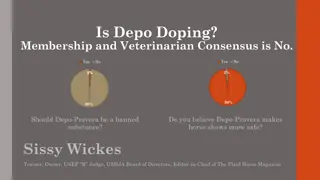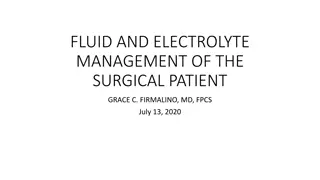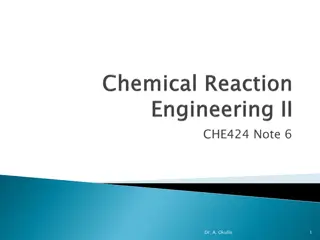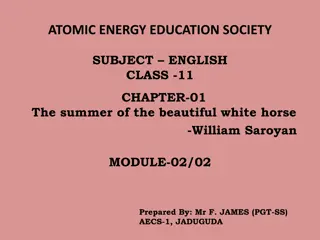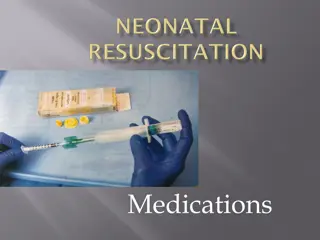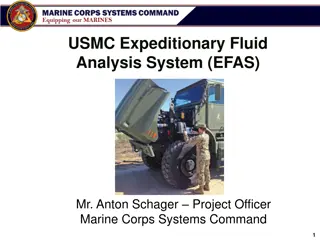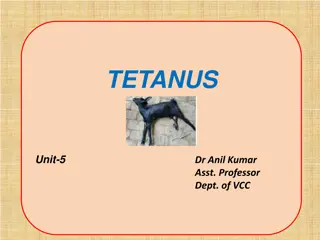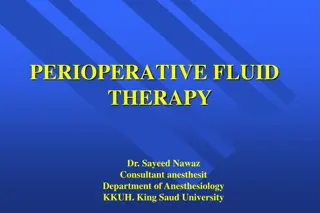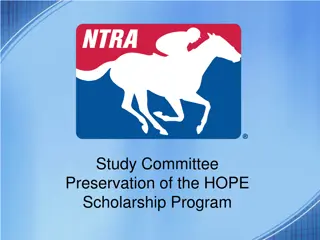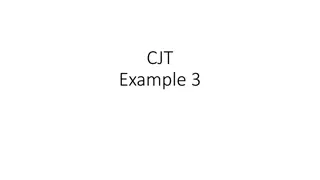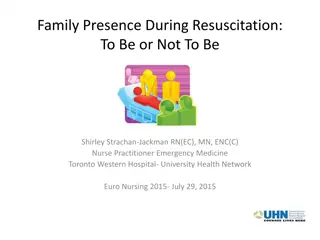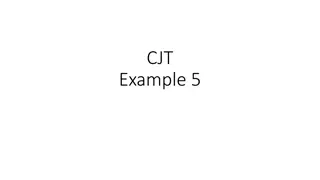
Clinical Judgement Test - Horse Fluid Resuscitation
In this case study, a 10-year-old warmblood gelding presents with acute febrile diarrhea and signs of dehydration. The need for fluid resuscitation is discussed, considering fluid deficits, ongoing losses, and the selection of appropriate fluids. Various aspects of clinical decision-making and assessment are highlighted, providing valuable insights for examination preparation.
Download Presentation

Please find below an Image/Link to download the presentation.
The content on the website is provided AS IS for your information and personal use only. It may not be sold, licensed, or shared on other websites without obtaining consent from the author. If you encounter any issues during the download, it is possible that the publisher has removed the file from their server.
You are allowed to download the files provided on this website for personal or commercial use, subject to the condition that they are used lawfully. All files are the property of their respective owners.
The content on the website is provided AS IS for your information and personal use only. It may not be sold, licensed, or shared on other websites without obtaining consent from the author.
E N D
Presentation Transcript
CJT Example 3
Clinical judgement test Aims Test clinical application and ability to justify clinical decision making Knowledge of disease pathophysiology Knowledge of the evidence base on which decision are made References As with previous cases reference are not provided but reviewing this evidence is considered useful in your preparation for examination.s.
SIGNALMENT PRESENTING SIGNS HISTORY A 10 year old warmblood gelding (600kg) Acute febrile diarrhoea Presented in September in the UK with a 48 hour history of pyrexia (40.5) and diarrhoea (pipe stream). The horse is used for general riding at a moderate level. It vaccinated against influenza and tetanus. It is stabled in a livery yard of 25 horses, with shared grazing. Faeces are collected from the pasture twice weekly and there twice monthly faecal sampling of the entire group and all horses with >200 epg are dosed with pyrantel during the grazing season. This horse received no anthelmintics this season (fwec 50 epg) All in contact horses are normal. The horse has been treated with 1.1mg/kg flunixin meglumine prior to presentation Case On presentation the horse is depressed Heart rate of 76bpm and respiratory rate of 23. Rectal Temperature is 38.7C Mucous membranes are congested and tacky with a prolonged skin tent Physical examination blood lactate is 7.5mmol/l (normal range <2.0mmol/l) Clinicopathological data are shown below Question 1: Discuss the need for fluid resuscitation of this horse? FURTHER INFORMATION WILL PRESENTED DURING THE COURSE OF THE EXAMINATION
stop THE REMAINDER OF THIS CASE WOULD BE PRESENTED DURING YOUR ASSESSMENT
Question 1 Discuss, justifying your decisions, a plan for fluid resuscitation of this horse?(40) Prompt: What are the fluid deficits, estimate losses and formulate a plan Unacceptable The good generalist A new diplomate The advanced diplomate Mentions fluid deficits but does not use estimates to calculate Describes use of PCV and skin tent as predictors of deficits but does not describe cut-offs Estimates the fluid deficits and describes how HR, PCV and lactate are used to predict fluid deficits alongside skin tent for example giving thresholds Critiques the limitations of laboratory indicators of hypovolaemia (TP) for example discussing hypoalbinaemia, other causes of hyperlactaemia identifies other factors to consider (acid base etc) Does not recognise both hypovolaemic and dehdrated Identifies hypovolaemia and dehydration but unable to explain how the two are differentiated Describes the horse as being hyovolaemic and dehydrated and describes criteria for these Critiques the criteria to differentiate hypovolaemia and dehydration and describes limitations of these criteria and or the value of these in relation to the use of resuscitation solutions (eg hypertonic saline) Estimates are not based on deficits Estimates fluid deficits (60l) with limited justification and no mention of ongoing loses Estimates (and justifies) fluid deficit (60l) and mentions ongoing losses Calculates and justifies current deficit, develops a plan for delivery (initial rates and ongoing replacements). Fluid selected without justification Indicates use of LRS with limited justification Justifies the use of crystalloid fluids (eg LRS) based on current deficits Justifies the use of crystalloids and colloids based on predicted hypoalbuminaemia post replacement. Use of resuscitation and maintenance fluids
You initiate fluid resuscitation using lactated ringers solution
Question 2 Describe your other therapeutic imperatives for this horsesPrompt what are the main clinical problems how will you manage these. Redirect candidates if antibiotics are mentioned Unacceptable The good generalist A new diplomate The advanced diplomate Identifies abnormal wbc but unable to recognise SIRS Predicts sepsis / SIRS based on WBC alone Predicts SIRS based on abnormal TPR and WBC Critiques evidence of prediction of SIRS based on limited criteria / compares to other species Discusses anti- endotoxic doses of flunixin and or antibiotics Discusses use of NSAIDs and other putative targets (polymixin, pentoxifylline or DMSO) without discussing evidence Discusses evidence of use of flunixin or other NSAIDs in managing sirs. Briefly reviews limited evidence of other therapeutic targets Discusses therapeutics and evidence base for therapeutics in the management of sepsis Mentions low total protein despite high PCV Discusses low albumin without discussing impact of crystalloid therapy and need for plasma transfusion Recognizes that low oncotic pressure will be exacerbated by crystalloid therapy and recommends plasma without differentiated fresh frozen/ fresh/ frozen Recognizes need for colloid support and is able to discuss benefit of different colloids startches vs fresh plasma vs hyperimmune plasma Highlights electrolyte abnormalities Discusses impact of calcium to GI function Discusses relevance of Mg Ca in view of albumin, role of Ca in GI disurbance Discusses calcium dysregulation in sepsis mediated through calcitonin. Need for ionised calcium
Question 3 Discuss the rationale for antibiotic therapy (20) Unacceptable The good generalist A new diplomate The advanced diplomate Rationalises antibiotic basis on presence of leucocytosis. Rationalises antibiotic basis on presence of leucocytosis and sepsis and presence of intestinal bacterial translocation and sepsis. Rationalises antibiotic use on basis of secondary responses to sepsis and management of sepsis Critically evaluates evidence for antibiotic use in sepsis / acute febrile diarrhoes Names suitable antibiotic with superficial explanations (routes, etc) Determines antibiotic protocol (drugs and duration/ end points) with limited rationale Determines antibiotic protocol and mentions G+ and G- roles in sepsis and need for antibiotics to consider likely bacterial with limited discussion of resistance mechanisms and cost-benefit Critically evaluates benefits of antibiotics and balances this against risks of antibiotic resistance through plasmid transfer of enterobacteriacae. Identifies GI depopulation is not relevant
Scores Question No answer (0) Unacceptable (2) Good generalist (4) New diplomate (6) Experienced diplomate (10) 1 1 1 1 2 2 2 2 3 3



